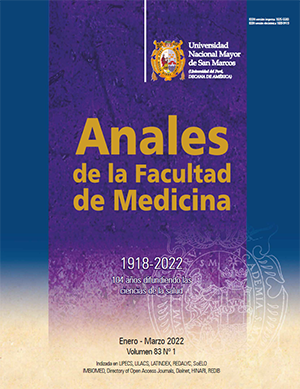Frequency of hypertriglyceridemic waist phenotype and its association with metabolic abnormalities in adolescents from a Andean region of Peru
DOI:
https://doi.org/10.15381/anales.v83i1.21508Keywords:
Hypertriglyceridemic Waist, Adolescent, Peru, Prevalence, HypertriglyceridemiaAbstract
Introduction. The hypertriglyceridemic waist has been proposed as a phenotype with a strong association with the metabolic syndrome. The frequency of this phenotype in adolescents from Peru, including Andes population is unknown. Objective. To estimate the frequency of the hypertriglyceridemic waist and its association with metabolic abnormalities and other factors in Peruvian adolescents from an Andean region. Methods. We performed a data secondary analysis through cross-sectional design. We analyzed 397 randomly selected adolescents from two public schools in the Cajamarca city. We defined hypertriglyceridemic waist as the simultaneous presence of increased waist circumference (≥ 90th percentile for age and sex) and serum hypertriglyceridemia (≥110 mg/dL). We estimated the point prevalence of hypertriglyceridemic waist and their 95% confidence interval, we also performed a binary logistic regression analysis to identify associated risks. Results. The phenotype of hypertriglyceridemic waist was 2.01% (95%CI: 0.51 to 3.52). The most frequent component was hypertriglyceridemia with 39.55% (95%CI: 34.61 to 44.48), while increased waist circumference affected 3.02% (95%CI: 1.21 to 4.83). Excess weight was the only variable association with hypertriglyceridemic waist phenotype (adjusted OR: 62.7; 95%CI: 6.7 - 587.9; p<0.001). Conclusions. Two of one hundred adolescents aged 11 to 17 years living in a high Andean region of Peru had the hypertriglyceridemic waist phenotype. This phenotype was associated with excess weight.
Downloads
Published
Issue
Section
License
Copyright (c) 2022 Anales de la Facultad de Medicina

This work is licensed under a Creative Commons Attribution-NonCommercial-ShareAlike 4.0 International License.
Those authors who have publications with this magazine accept the following terms:
- Authors will retain their copyrights and guarantee the journal the right of first publication of their work, which will be simultaneously subject to Creative Commons Attribution License that allows third parties to share the work as long as its author and its first publication this magazine are indicated.
- Authors may adopt other non-exclusive licensing agreements for the distribution of the version of the published work (eg, deposit it in an institutional electronic file or publish it in a monographic volume) provided that the initial publication in this magazine is indicated.
- Authors are allowed and recommended to disseminate their work over the Internet (eg: in institutional telematic archives or on their website) before and during the submission process, which It can produce interesting exchanges and increase quotes from the published work. (See El efecto del acceso abierto ).



